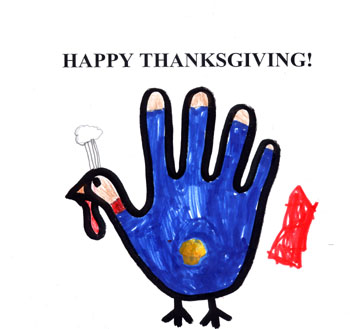The human mind seems to like creating things, and kids will use whatever tools are at their disposal to build. My uncle used to build death-defying systems of roadways with Hotwheels track and masking tape. A childhood friend of mine built elaborate structures out of Fig Newtons (largely because they were in abundance in her home and she couldn’t stand to actually eat them). When you have a creative itch, almost anything can serve as the scratcher. Here are some toys for building that are probably less likely to attract ants than are Fig Newtons:
Category Archives: Kids and science
Friday Sprog Blogging: snowflakes

The younger Free-Ride offspring cut this snowflake. But look again — that’s not just a snowflake, that’s a snowflake with the face of a monkey! Is this what floats down from the sky to make a winter wonderland of the Planet of the Apes? (Would a sufficient number of monkeyflakes be useful in making frozen banana daiquiris?). “No,” says younger offspring. “It’s just a cool shape for a paper snowflake. Eee-eee-eee-eee!“
Brain-Friendly Giftables, part 2: Games.
There are two features of games that have always appealed to me. First, the good ones put you in a place where you are explicitly thinking out different ways the future could play out — the possibilities that are more or less likely given what you know (and what you don’t know). Second, many of them let you drag someone else (whether your opponent or your teammate) into thinking through these situations, too.
Any game where you have to make choices about what to do involves some sort of strategy, and formulating or refining strategies is a work-out for your brain. This means that games, in general, tend to be brain-friendly giftables. That said, here are some of the ones we like best:
Friday Sprog Blogging: what (and where) is science?
Dr. Free-Ride: What science have you been learning in school lately?
Younger offspring: We’ve been learning what animals are nocturnal and what animals are diurnal.
Dr. Free-Ride: What other science have you learned this year?
Younger offspring: Oh, lots of different things.
Dr. Free-Ride: Hey, if there were a new kid in your class who hadn’t had science before, how would you explain what science is? How would you be able to tell it apart from reading or math or writing your letters?
Younger offspring: Science is something you learn from parent helpers.
Dr. Free-Ride: Huh?
Younger offspring: Because [Dr. Free-Ride’s better half] teaches it to our class!
Dr. Free-Ride: Oh.
What’s the best way to excite kids about science (or at least not convince them it’s boring or impossible)?
On the heels of my post wondering where the science is in elementary school, I’m interested in your sense of how things stand now and what, if anything, you think we should do about the situation. Draw on your experience as a former (or current) student, a parent, an educator (including educating future teachers), a working scientist, or whatever.
The possibilities that have been raised so far seem to be:
How much science is there in elementary school “science”?
My better half has been a frequent classroom volunteer leading science lessons in younger offspring’s kindergarten class. This has made it fairly apparent to us that there’s very little of what either of us would identify as science in these lessons.
Friday Sprog Blogging: Thanksgiving week.
 The Free-Ride offspring spent Thanksgiving with the Grandparents Who Lurk But Seldom Comment, cutting into the opportunities for the Free-Ride parents to ask them about matters scientific. Nonetheless, the sprogs have been doing science-y things on their vacation from parents. Two highlights:
The Free-Ride offspring spent Thanksgiving with the Grandparents Who Lurk But Seldom Comment, cutting into the opportunities for the Free-Ride parents to ask them about matters scientific. Nonetheless, the sprogs have been doing science-y things on their vacation from parents. Two highlights:
- A visit to the Griffith Observatory, where they not only took in a planetarium show, but also weighed themselves on Mercury. (Both elder offspring and younger offspring weighed in at zero — clearly Mercury is the right planet to visit after a heavy Thanksgiving meal!)
- A visit to the California Science Center. The sprogs especially liked exhibits on animation (not only because there were lots of funny cartoon clips, but also because there were interesting how-tos) and on how airplanes fly (since, as elder offspring explains, “you can make anything fly if you know how to shape a wing”). They also took in an IMAX film, Deep Sea 3D, which featured fish, jellyfish, sharks, Humboldt squid, octopus — lots of old favorites.
There was also some feeding of ducks, I’m told.
Meanwhile, the Free-Ride parents took a hike.
Two NYT stories worth a look.
Some readers have called to my attention a pair of recent stories from the New York Times that you may find interesting.
First, Audrey noted another dispatch on the eternal struggle over how math ought to be taught:
Brain-Friendly Giftables, part 1: Books.
As promised, I bring you some gift recommendations for kids who are into math or science (or could be if presented with the right point of entry). The first installation: books.
Books are the best. They don’t need batteries or assembly. They don’t have lots of little parts that will end up strewn on the floor (or lost under the couch). You can read them alone or read them with others.
You can buy ’em new, but you can also find some amazing books at used bookstores, or garage sales, or library sales. And of course, if you have a library card you can partake of an astounding number of titles for free (provided you return them by the due date)!
Esteemed reader Jake also reminds us that, especially for younger kids, the real present isn’t the book so much as the time you spend reading the book to them:
This is an eminently affordable gift if one makes use of the public library. A promise of a read aloud every night before bedtime can provide many benefits to both parent and child. It definitely counts as quality together time. If the books that are read are a bit ahead of the child’s own reading level, but not ahead of their comprehension, then they can help provide curiosity about what more there is to be found in the world of books, can help expand vocabulary, can provide a vehicle for the child to ask questions about various things/situations/ideas in a comfortable situation, and can help relax an active child so that bedtime doesn’t become a stressful event.
It doesn’t matter if what you read is fiction, science, history, or biography, so long as the child is interested and engaged.
If they are old enough to sit up and focus, they’re old enough to start enjoying books.
With that sage advice, here are my recommendations.
Friday Sprog Blogging: recent images from elder offspring.
A conversation this morning:
Dr. Free-Ride: Hey, do you have any pictures you’d like me to scan in for today’s sprog blog?
Younger offspring: No.
Dr. Free-Ride: You mean to tell me you haven’t made any drawings at all this week?
Younger offspring: I’ve made drawings, but I don’t want to scan any of them for your blog.
Dr. Free-Ride: You’re not in negotiations with another blogger, are you?
Younger offspring: Not yet.
* * * * *
